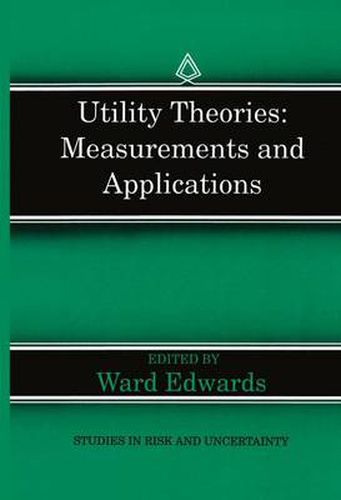Readings Newsletter
Become a Readings Member to make your shopping experience even easier.
Sign in or sign up for free!
You’re not far away from qualifying for FREE standard shipping within Australia
You’ve qualified for FREE standard shipping within Australia
The cart is loading…






This title is printed to order. This book may have been self-published. If so, we cannot guarantee the quality of the content. In the main most books will have gone through the editing process however some may not. We therefore suggest that you be aware of this before ordering this book. If in doubt check either the author or publisher’s details as we are unable to accept any returns unless they are faulty. Please contact us if you have any questions.
Traditional utility theory, growing out of the ideas of von Neumann & Morgenstern and Savage, asserts that wise decision makers should maximize some form of expected utility. Decision analysis as a technology implements this prescription. But even after careful thought, people do not necessarily behave that way. The new generalized utility theories attempt to model what people actually do. This book grows out of a NSF-sponsored Conference that brought generalized utlilty theorists and decision analysts together to examine the normative, prescriptive and descriptive implications of the new utility theories. The book begins with a review of the phenomena that the new utility theories are intended to explain and of the theories themselves. It then presents the old time religion of utility maximization as a normative and prescriptive theory. It explores how utility maximization needs to be and can be amplified and supplemented for practical prescriptive purposes. The next section of the book looks at what characteristics generalized utility theories would need to have in order to be prescriptively useful. The crucial one turns out to be a form of path independence. Two chapters show that the form of path independence essentially forces the theory embodying it to be a version of traditional utility maximization. The next section of the book looks at the relation between generalized utility theories and the data they are intended to explain. A final section contains an evaluative discussion that weaves the themes of the book together. Utility Theories: Measurements and Applications provides a definitive answer to the question about the relation between new utility theories and decision analysis that inspired it. It also brings into focus a number of related questions, and reports a great deal of theoretical and empirical progress on the topics to which it is addressed.
$9.00 standard shipping within Australia
FREE standard shipping within Australia for orders over $100.00
Express & International shipping calculated at checkout
This title is printed to order. This book may have been self-published. If so, we cannot guarantee the quality of the content. In the main most books will have gone through the editing process however some may not. We therefore suggest that you be aware of this before ordering this book. If in doubt check either the author or publisher’s details as we are unable to accept any returns unless they are faulty. Please contact us if you have any questions.
Traditional utility theory, growing out of the ideas of von Neumann & Morgenstern and Savage, asserts that wise decision makers should maximize some form of expected utility. Decision analysis as a technology implements this prescription. But even after careful thought, people do not necessarily behave that way. The new generalized utility theories attempt to model what people actually do. This book grows out of a NSF-sponsored Conference that brought generalized utlilty theorists and decision analysts together to examine the normative, prescriptive and descriptive implications of the new utility theories. The book begins with a review of the phenomena that the new utility theories are intended to explain and of the theories themselves. It then presents the old time religion of utility maximization as a normative and prescriptive theory. It explores how utility maximization needs to be and can be amplified and supplemented for practical prescriptive purposes. The next section of the book looks at what characteristics generalized utility theories would need to have in order to be prescriptively useful. The crucial one turns out to be a form of path independence. Two chapters show that the form of path independence essentially forces the theory embodying it to be a version of traditional utility maximization. The next section of the book looks at the relation between generalized utility theories and the data they are intended to explain. A final section contains an evaluative discussion that weaves the themes of the book together. Utility Theories: Measurements and Applications provides a definitive answer to the question about the relation between new utility theories and decision analysis that inspired it. It also brings into focus a number of related questions, and reports a great deal of theoretical and empirical progress on the topics to which it is addressed.